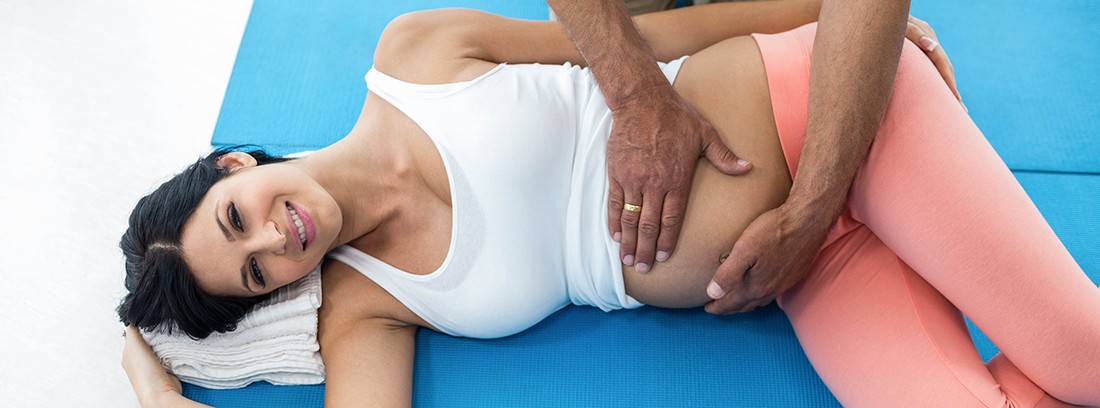Benefits of physical therapy in pregnancy

Obstetrics is also a field that physiotherapy encompasses, and due to its high demand there are more and more specialized physiotherapists in this ambit. The techniques and resources used have shown great benefits in the face of the physical changes experienced during pregnancy and natural childbirth. Now, what role does the physical therapy during pregnancy? Well, it is basically responsible for physical preparation for childbirth and addressing problems and pathologies that may appear during pregnancy and postpartum. Next, we will detail in what way and what are its real benefits and some exercises that you can practice.
Changes during pregnancy, what are they and what do they cause?
Hormonal changes such as the secretion of estrogens and progesterone cause physical changes in the pregnant woman in order to be able to accommodate the fetus during gestation and pregnancy. These changes affect the biomechanics of the body and can cause disorders such as instabilities or dysfunctions in the body.
- Increased progesterone it entails a decrease in the tone of the smooth muscles, which is why the bladder and urethral pressure are affected, in addition to the perineum muscle. Problems such as urinary incontinence, prolapses or discomfort during sexual intercourse appear.
- the rise of relaxin makes all the connective tissue decrease its tension causing it to be looser affecting ligaments and fasciae in general. This phenomenon causes low back pain due to instability of the lumbar vertebrae ligaments, abdominal diastasis (distention of the abdominal muscles) or instability in the different joints such as knees, wrists, etc.
At the respiratory level, more oxygen is consumed, so the appearance of dyspnea (shortness of breath) due to exertion is greater. In addition, the normal breathing pattern changes from abdominal to thoracic due to the elevation of the diaphragm due to the pressure exerted by the pregnant woman's uterus.
How does physiotherapy intervene in pregnancy?
Physiotherapy in pregnancy it is easy to combine with other treatments since the therapy used is non-invasive and no drugs are used. Taking into account that pregnant women have restricted medication, the physiotherapist has become a benchmark during pregnancy, not only for analgesic treatments, such as to treat lumbopelvic pain or the typical swelling of the legs, but also throughout the process from preparation to childbirth and postpartum recovery.
How it works
The main goals of obstetric physical therapy are to facilitate natural childbirth and postpartum recovery… But how?
- Prepare the perineal tissue so that during vaginal delivery it does not tear and the appearance of dysfunctions can be prevented.
- Work on muscle control for the time of delivery, for example
- Acquire a respiratory control during contractions.
- Decrease ailments and circulatory problems during childbirth.
- Prevention of urinary incontinence, prolapses and dysfunctions of the through hypopressive exercises and training of the pelvic muscles.
During preparation for childbirth ...
If there are no contraindications, preparation for childbirth can be started during the second quarter. Workouts can last up to an hour and you have to avoid sudden movements, jumps and postures that put balance at risk and may cause a fall or injury. The type of exercise performed is gentle, prescribed and adapted to the pregnant woman and is based on the following:
- Exercises to tone the pectoral and pelvic muscles.
- Toning of the perineum to avoid episiotomy (tear of the perineum) during vaginal delivery through exercises and improve sexual intercourse.
- Gentle stretches to relax the muscles and reduce the tension in the muscle groups that can be affected by morphological changes such as the hip, gluteal or hamstring rotators or in the upper extremity the cervical and pectoral muscles. Better if they are directed not to overdo it due to joint laxity caused by relaxin secretion.
- Exercises for circulation. They consist of ankle and leg movements and self-massage of the plantar arch with a tennis ball to stretch the plantar fascia.
- Postural reeducation. It seeks to become aware of the body and to integrate the postural corrections of the new morphology of the pregnant woman's body during daily life.
- Exercises to train breathing and expulsion: relaxation techniques are used to improve pain during contractions, postures are also worked to improve labor during dilation and expulsion with the pilates ball or fitball.
- : the selective contraction of the pelvic floor muscles is worked to prevent urinary incontinence and prolapses. It is recommended to perform them before pregnancy or after childbirth for the recovery of the muscles.
- Hypopressive exercises: to recover the deep abdominal muscles and pelvic floor that are weakened by the weight bearing of the baby and hormonal changes. It is only indicated to perform them after quarantine. The physiotherapist specialized in obstetrics performs an assessment of the state of the musculature and guides the relevant exercises for its recovery.
You should always check if there are any contraindications to performing these exercises, especially if you want to start during the first trimester to prepare for childbirth and also during the postpartum period, since each situation is different. If there are any warning symptoms such as leaks, for example, the exercise will be stopped immediately and a doctor will be referred.
- As pregnant women have restricted medication, the physiotherapist has become a benchmark during pregnancy.
- Not only for analgesic treatments, such as for treating lumbopelvic pain or the typical swelling of the legs, but also for the entire process of preparation for childbirth and recovery during postpartum.
- You should always consult with the gynecologist if there is any contraindication to perform the exercises in preparation for childbirth.
(Updated at Apr 14 / 2024)